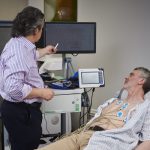What is an epigastric hernia?
An epigastric hernia is a lump in the midline between your belly button and sternum (breastbone) which can cause pain.
Your abdominal cavity contains your intestines and other structures. These are protected by your abdominal wall, which is made up of four layers.
In an epigastric hernia, fat pushes out through a weakness in the wall of your abdomen between your belly button and sternum and forms a lump. The most common symptom is pain caused by the fat being pinched by your abdominal wall.
-73f29f.png)
What are the benefits of surgery?
Surgery can help to relieve pain that is caused by the hernia.
Are there any alternatives to surgery?
The hernia can be left alone but pain caused by the hernia will usually continue and complications can happen. It will not get better without surgery.
What does the operation involve?
The operation is usually performed under a general anaesthetic but various anaesthetic techniques are possible.
The operation usually takes about 30 minutes. Your surgeon will make a cut over the hernia and free up the ‘hernial sac’.
If only fat is pushing through, your surgeon will either remove the fat or push it back. If contents of your abdomen are also pushing through, they will place the contents back inside your abdomen.
Your surgeon will remove the hernial sac and close the weak spot with strong stitches or a synthetic mesh.
How can I prepare myself for the operation?
If you smoke, stopping smoking now may reduce your risk of developing complications and will improve your long-term health.
Try to maintain a healthy weight. You have a higher risk of developing complications if you are overweight.
Regular exercise should help to prepare you for the operation, help you to recover and improve your long-term health. Do not do exercises that involve heavy lifting or make your hernia painful. Before you start exercising, ask the healthcare team or your GP for advice.
Speak to the healthcare team about any vaccinations you might need to reduce your risk of serious illness while you recover. When you come into hospital, practise hand washing and wear a face covering when asked.
What complications can happen?
Some complications can be serious and can even cause death.
General complications of any operation
- bleeding
- infection of the surgical site (wound)
- allergic reaction to the equipment, materials or medication
- blood clot in your leg
- blood clot in your lung
- chest infection
Specific complications of this operation
- developing a collection of blood (haematoma) or fluid (seroma) under your wound
- injury to structures within your abdomen
Consequences of this procedure
- pain
- unsightly scarring of your skin
How soon will I recover?
You should be able to go home the same day.
You should be able to return to work after 1 to 2 weeks, depending on how much surgery you need and your type of work.
Do not lift anything heavy for at least 6 weeks.
Regular exercise should help you to return to normal activities as soon as possible. Before you start exercising, ask the healthcare team or your GP for advice.
Most people make a full recovery and can return to normal activities. The hernia can come back many years later and you may need another operation.


